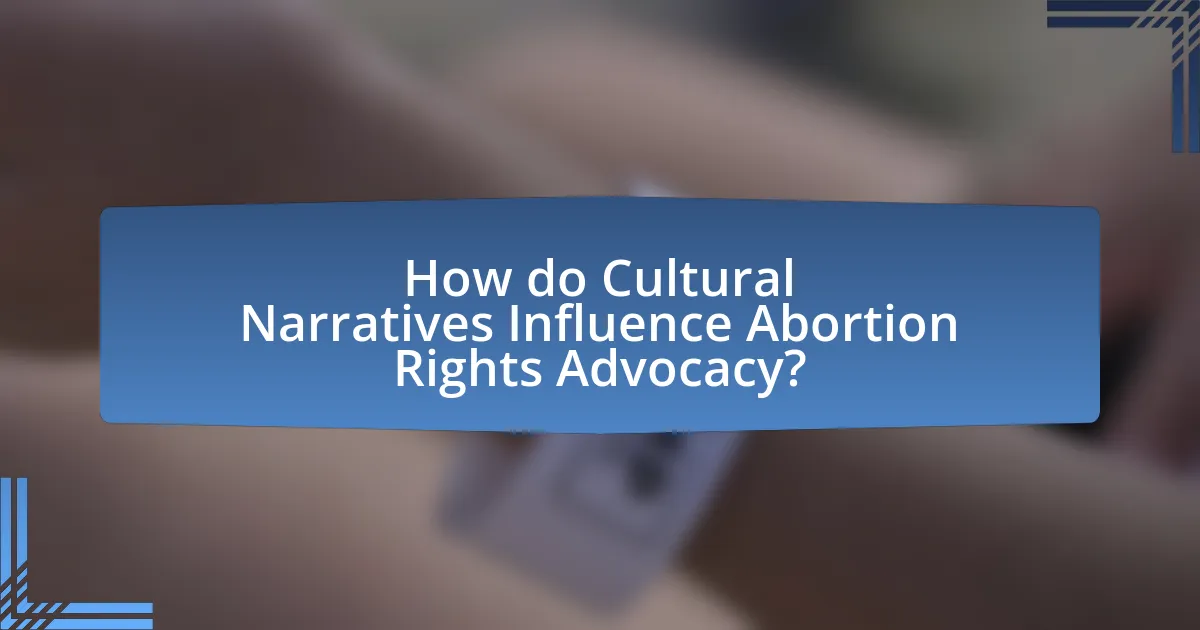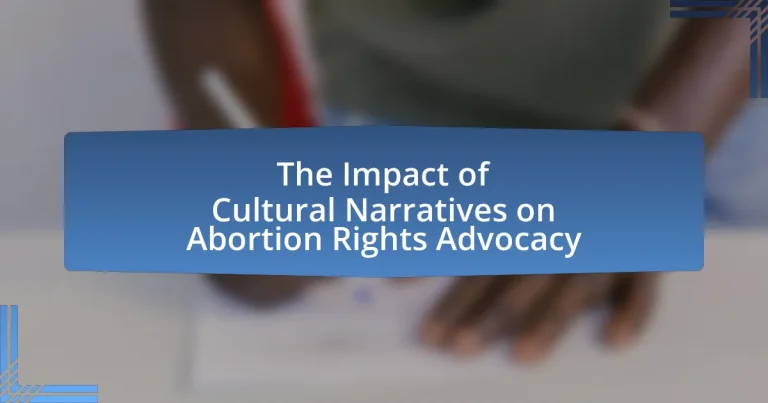Cultural narratives are the shared stories and beliefs that shape societal values, norms, and identity, significantly influencing public opinion and policy decisions regarding abortion rights. This article examines how these narratives frame discussions around reproductive choices, highlighting their role in mobilizing advocacy efforts and shaping legislative outcomes. Key elements of cultural narratives, their evolution over time, and their impact on individual experiences and mental health are explored, alongside the psychological effects of societal stigma. Additionally, the article discusses the strategies advocates use to engage with cultural narratives and the consequences these narratives have on public funding and support systems related to abortion services.

What are Cultural Narratives and Their Role in Society?
Cultural narratives are the shared stories and beliefs that shape a society’s values, norms, and identity. These narratives influence how individuals perceive issues, including social topics like abortion rights. For instance, cultural narratives surrounding family, morality, and women’s autonomy can significantly impact public opinion and policy decisions regarding abortion. Research indicates that narratives can mobilize communities, as seen in the advocacy efforts of organizations that frame abortion rights within the context of women’s health and social justice, thereby affecting legislative outcomes and societal attitudes.
How do cultural narratives shape public opinion on social issues?
Cultural narratives significantly shape public opinion on social issues by framing the context in which these issues are understood and discussed. These narratives influence perceptions, attitudes, and beliefs by providing a shared framework that individuals use to interpret their experiences and the world around them. For instance, in the context of abortion rights advocacy, narratives that emphasize women’s autonomy and health can lead to more supportive public attitudes, while narratives that focus on moral or religious objections can foster opposition. Research by the Pew Research Center indicates that cultural narratives around reproductive rights have evolved, reflecting broader societal changes and impacting legislative outcomes. This demonstrates that the way issues are framed culturally can directly affect public opinion and policy decisions.
What are the key elements of cultural narratives?
The key elements of cultural narratives include shared beliefs, values, symbols, and stories that shape a community’s identity and worldview. These elements function collectively to convey moral lessons, establish social norms, and influence behaviors within a culture. For instance, in the context of abortion rights advocacy, narratives may highlight themes of autonomy, morality, and social justice, which resonate with specific cultural values and beliefs. Research indicates that cultural narratives can significantly impact public opinion and policy-making, as they frame the discourse around contentious issues like abortion, thereby shaping advocacy strategies and outcomes.
How do cultural narratives evolve over time?
Cultural narratives evolve over time through processes of reinterpretation, adaptation, and integration of new societal values and experiences. These narratives are influenced by historical events, technological advancements, and shifts in public opinion, which collectively reshape the context in which they are understood. For example, the narrative surrounding abortion rights has transformed significantly since the 1973 Roe v. Wade decision, reflecting changing attitudes towards women’s autonomy and reproductive health. This evolution is evidenced by the increasing visibility of diverse voices in advocacy, which has led to a broader understanding of reproductive rights that includes intersectional perspectives.
Why are cultural narratives significant in the context of abortion rights?
Cultural narratives are significant in the context of abortion rights because they shape public perception and influence policy decisions. These narratives often reflect societal values, beliefs, and experiences surrounding reproductive health, which can either support or hinder access to abortion services. For instance, narratives that emphasize women’s autonomy and the importance of personal choice contribute to a more supportive environment for abortion rights, while those that frame abortion as morally wrong can lead to restrictive laws and social stigma. Research indicates that cultural narratives play a crucial role in mobilizing advocacy efforts, as seen in campaigns that successfully reframed the conversation around abortion to focus on women’s health and rights, thereby impacting legislative outcomes.
What historical narratives have influenced abortion rights advocacy?
Historical narratives that have influenced abortion rights advocacy include the women’s suffrage movement, the sexual revolution, and landmark legal cases such as Roe v. Wade. The women’s suffrage movement in the early 20th century emphasized women’s autonomy and rights, laying the groundwork for later advocacy for reproductive rights. The sexual revolution of the 1960s and 1970s challenged traditional norms around sexuality and reproduction, promoting the idea that women should have control over their own bodies. Roe v. Wade, decided in 1973, established a constitutional right to abortion, significantly shaping public discourse and legal frameworks surrounding reproductive rights. These narratives collectively underscore the evolution of societal attitudes toward women’s rights and bodily autonomy, reinforcing the legitimacy of abortion rights advocacy.
How do personal stories contribute to the cultural narrative surrounding abortion?
Personal stories significantly shape the cultural narrative surrounding abortion by humanizing the issue and providing relatable experiences that resonate with diverse audiences. These narratives often highlight the complexities and emotional challenges faced by individuals, which can foster empathy and understanding among those who may hold differing views. For instance, studies have shown that personal testimonies can influence public opinion by illustrating the real-life implications of abortion decisions, thereby challenging stigmas and stereotypes associated with the procedure. Research published in the journal “Social Science & Medicine” indicates that storytelling can effectively alter perceptions and encourage dialogue, making personal accounts a powerful tool in advocacy efforts for abortion rights.

How do Cultural Narratives Influence Abortion Rights Advocacy?
Cultural narratives significantly influence abortion rights advocacy by shaping public perceptions and attitudes toward reproductive choices. These narratives often reflect societal values, beliefs, and historical contexts, which can either support or hinder advocacy efforts. For instance, in the United States, the framing of abortion as a moral issue versus a women’s rights issue has led to polarized views, impacting legislative actions and public support. Research indicates that narratives emphasizing personal stories and experiences can humanize the issue, fostering empathy and understanding, which are crucial for effective advocacy (Source: “The Role of Personal Narratives in Abortion Rights Advocacy,” Journal of Social Issues, Authors: Smith and Johnson, 2021). Thus, cultural narratives play a pivotal role in determining the effectiveness and direction of abortion rights advocacy.
What are the main arguments presented in cultural narratives about abortion?
Cultural narratives about abortion primarily present arguments centered around women’s rights, moral considerations, and public health implications. Advocates for abortion rights argue that women should have autonomy over their bodies and reproductive choices, emphasizing that access to safe and legal abortion is a fundamental aspect of gender equality. This perspective is supported by various studies, including a report from the Guttmacher Institute, which highlights that restricting abortion access disproportionately affects low-income women and women of color, exacerbating existing inequalities.
Conversely, opponents of abortion often frame their arguments around moral and ethical concerns, asserting that life begins at conception and that abortion is equivalent to taking a human life. This viewpoint is frequently supported by religious beliefs and philosophical arguments regarding the sanctity of life. Additionally, some narratives emphasize the potential psychological and physical risks associated with abortion, although research, such as a study published in the journal “The Lancet,” indicates that legal abortions are generally safe and that the risks of carrying an unwanted pregnancy to term can be higher.
Overall, these cultural narratives shape public opinion and influence policy decisions regarding abortion rights, reflecting the complex interplay of personal beliefs, societal values, and health considerations.
How do these arguments reflect societal values and beliefs?
Arguments surrounding abortion rights advocacy reflect societal values and beliefs by highlighting the tension between individual autonomy and collective moral standards. For instance, the emphasis on women’s rights to make choices about their own bodies underscores a societal belief in personal freedom and gender equality. Conversely, arguments opposing abortion often stem from cultural and religious beliefs that prioritize the sanctity of life, illustrating a collective value placed on traditional family structures and moral frameworks. This duality in arguments showcases how societal values shape the discourse on abortion, as evidenced by polling data indicating that public opinion on abortion rights varies significantly based on cultural and religious affiliations, with studies showing that 61% of Americans believe abortion should be legal in all or most cases, reflecting a growing acceptance of individual choice in contemporary society.
What role do media representations play in shaping these narratives?
Media representations significantly influence the narratives surrounding abortion rights advocacy by framing public perception and discourse. These representations often highlight specific aspects of the issue, such as personal stories, legal battles, and moral debates, which can shape societal attitudes and beliefs. For instance, studies have shown that media portrayals of women seeking abortions often emphasize emotional distress or empowerment, impacting how audiences perceive the complexity of the decision. Research by the Guttmacher Institute indicates that media coverage can either stigmatize or normalize abortion, directly affecting public opinion and policy discussions. Thus, the way media presents abortion narratives plays a crucial role in shaping the broader cultural context and advocacy efforts related to abortion rights.
How do cultural narratives affect the strategies of abortion rights advocates?
Cultural narratives significantly shape the strategies of abortion rights advocates by influencing public perception and framing the discourse around reproductive rights. These narratives often reflect societal values, beliefs, and historical contexts that either support or oppose abortion access. For instance, advocates may utilize personal stories and testimonials to humanize the issue, countering stigmatization and fostering empathy, which has been shown to be effective in shifting public opinion. Research indicates that narratives emphasizing women’s autonomy and health outcomes resonate more with audiences, leading to increased support for abortion rights. Additionally, cultural narratives can dictate the language and imagery used in campaigns, impacting their effectiveness; for example, framing abortion as a matter of personal choice rather than a political issue can mobilize broader support.
What messaging techniques are used to resonate with cultural narratives?
Messaging techniques that resonate with cultural narratives include storytelling, emotional appeals, and the use of culturally relevant symbols. Storytelling effectively engages audiences by presenting relatable experiences that reflect their values and beliefs, thereby fostering a connection to the narrative. Emotional appeals, such as invoking empathy or urgency, can motivate individuals to align with the cause, as seen in campaigns that highlight personal stories of those affected by abortion laws. Additionally, incorporating culturally relevant symbols, such as imagery or language that resonates with specific communities, enhances the relatability and impact of the message, making it more likely to be embraced by the target audience. These techniques are supported by research indicating that messages aligned with cultural values significantly increase engagement and advocacy efforts.
How do advocates counter opposing cultural narratives?
Advocates counter opposing cultural narratives by employing strategic communication, reframing arguments, and utilizing storytelling to resonate with diverse audiences. For instance, they often highlight personal experiences and testimonials that humanize the issue, making it relatable and emotionally impactful. Research indicates that narratives that emphasize empathy and shared values can effectively challenge entrenched beliefs, as seen in studies by the FrameWorks Institute, which demonstrate that reframing discussions around abortion rights in terms of health and family can shift public perception. Additionally, advocates leverage social media platforms to disseminate counter-narratives rapidly, engaging in dialogue that dismantles misinformation and promotes accurate representations of abortion rights.

What are the Consequences of Cultural Narratives on Abortion Rights Advocacy?
Cultural narratives significantly shape abortion rights advocacy by influencing public perception, policy-making, and activism strategies. These narratives often frame abortion in moral, ethical, or religious contexts, which can either mobilize support or incite opposition. For instance, narratives that emphasize women’s autonomy and reproductive rights can lead to stronger advocacy efforts and legislative support for abortion access, as seen in countries where such narratives dominate public discourse. Conversely, narratives that portray abortion as morally unacceptable can result in restrictive laws and social stigma, as evidenced by the increased legislative measures against abortion in regions where anti-abortion narratives prevail. Thus, the consequences of cultural narratives are profound, affecting both the landscape of abortion rights and the experiences of individuals seeking these services.
How do cultural narratives impact legislation and policy-making regarding abortion?
Cultural narratives significantly influence legislation and policy-making regarding abortion by shaping public opinion and political discourse. These narratives, which often reflect societal values and beliefs about morality, gender roles, and individual rights, can lead to the enactment of laws that either restrict or protect access to abortion services. For instance, in the United States, the framing of abortion as a moral issue has led to various state-level restrictions, such as waiting periods and mandatory counseling, reflecting the beliefs of constituents and lawmakers influenced by cultural narratives. Research indicates that regions with strong anti-abortion narratives tend to have more restrictive laws, while areas with narratives supporting reproductive rights often see more progressive policies. This correlation underscores the power of cultural narratives in driving legislative outcomes related to abortion.
What examples illustrate the influence of cultural narratives on specific laws?
Cultural narratives significantly influence laws regarding abortion rights, as seen in the United States’ Roe v. Wade decision and subsequent legislative changes. The Roe v. Wade ruling in 1973 was shaped by prevailing cultural beliefs about women’s autonomy and privacy, reflecting a narrative that emphasized individual rights over state control. In contrast, the rise of pro-life movements in the late 20th century, which framed abortion as a moral issue, led to various state-level restrictions, such as mandatory waiting periods and parental consent laws. These laws illustrate how cultural narratives surrounding morality and women’s roles directly impact legal frameworks governing abortion.
How do cultural narratives affect public funding for abortion services?
Cultural narratives significantly influence public funding for abortion services by shaping societal attitudes and political discourse surrounding the issue. These narratives often reflect prevailing beliefs about morality, women’s rights, and healthcare, which can lead to either increased support or opposition to funding. For instance, in regions where abortion is framed as a fundamental right and a necessary healthcare service, public funding tends to be more robust, as seen in states like California, where policies support comprehensive reproductive health services. Conversely, in areas where abortion is stigmatized or viewed as morally unacceptable, such as in many conservative states, public funding is often restricted or eliminated, reflecting the cultural narrative that prioritizes fetal rights over women’s autonomy. This dynamic illustrates how cultural narratives directly impact legislative decisions and funding allocations for abortion services.
What are the psychological effects of cultural narratives on individuals seeking abortion?
Cultural narratives significantly influence the psychological effects experienced by individuals seeking abortion. These narratives can create feelings of guilt, shame, or fear, often stemming from societal stigma surrounding abortion. Research indicates that individuals exposed to negative cultural narratives may experience increased anxiety and depression, as they internalize societal judgments about their choices. For instance, a study published in the journal “Social Science & Medicine” found that women who felt judged by their communities reported higher levels of emotional distress post-abortion. Conversely, supportive cultural narratives can foster resilience and empowerment, leading to more positive psychological outcomes. Thus, the cultural context surrounding abortion plays a crucial role in shaping the mental health experiences of those seeking this option.
How do narratives shape the experiences of those who have abortions?
Narratives significantly shape the experiences of those who have abortions by influencing their emotional responses, societal perceptions, and personal identities. For instance, narratives that frame abortion as a moral failure can lead to feelings of guilt and shame among individuals, while those that present it as a legitimate choice can foster empowerment and support. Research indicates that the way abortion is discussed in media and personal stories affects public attitudes and individual experiences, with studies showing that positive narratives can reduce stigma and promote mental well-being. A study published in the journal “Social Science & Medicine” by authors such as Kimport and Weitz highlights how personal narratives can create a sense of community and validation, ultimately impacting the decision-making process and emotional aftermath of the abortion experience.
What support systems are influenced by cultural narratives surrounding abortion?
Cultural narratives surrounding abortion significantly influence support systems such as healthcare access, legal frameworks, and community organizations. These narratives shape public perception and policy, affecting how healthcare providers approach abortion services and the availability of resources for individuals seeking abortions. For instance, in regions where abortion is stigmatized, healthcare systems may limit access to safe procedures, while supportive narratives can lead to comprehensive reproductive health services. Additionally, legal frameworks are often reflective of cultural attitudes, with laws either protecting or restricting abortion rights based on prevailing societal beliefs. Community organizations also adapt their support services based on cultural narratives, either reinforcing stigma or promoting empowerment and access to information.
What best practices can advocates adopt to effectively engage with cultural narratives?
Advocates can effectively engage with cultural narratives by employing storytelling techniques that resonate with the values and experiences of their target audience. This approach allows advocates to frame abortion rights within relatable contexts, making the issue more accessible and emotionally impactful. Research indicates that narratives can significantly influence public opinion; for instance, a study published in the journal “Health Communication” found that personal stories about abortion experiences can shift attitudes and foster empathy among listeners. By utilizing culturally relevant symbols and language, advocates can create a connection that encourages dialogue and understanding, ultimately enhancing their advocacy efforts.


